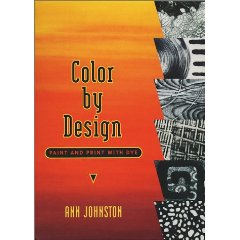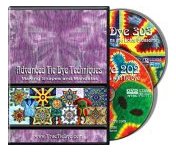—ADVERTISEMENTS—

Ann Johnston's book
Color by Design: Paint and Print with Dye
Tom Rolofson and Martine Purdy's DVD

Advanced Tie Dye Techniques: Making Shapes and Mandalas
—ADVERTISEMENTS—
—ADVERTISEMENTS—


The intensity of color on your dyed fiber will depend on how much dye powder you use per weight of fiber. For pale pastels, use a tiny amount of dye; for dark colors, use more dye than usual; and for a good dark black, use up to four times as much dye as usual.
If you're dyeing a lot of material, obviously you will need more dye. The rules you see for how much dye to use all assume one pound of fiber, whether you're dyeing ready-made clothing, fabric yardage, yarn, or unspun fiber. You will need to be able to weigh your fiber. Bathroom scales don't do well on weights below ten pounds. You can use a postal scale or your kitchen scale. (We're not supposed to use our kitchen scales for dyes or other non-food chemicals, but there's no reason not to use them to weigh clean fibers.) Remember that one US pound is 16 ounces or 454 grams; one ounce is 28 grams. You'll find the math a lot easier if you convert to metric units instead of trying to work with pounds and ounces. Many scales have a switch on the back to convert between grams and ounces, or you can just use a calculator.
Unlike the Cibacron F dyes (now sold as Novacron, or as Sabracron by ProChem), the Procion dyes are not standardized to a similar tinctoral strength per color. Even among the mostly undiluted single-hue Procion MX type dyes, some require more dye to get a similar intensity of color.
ProChem's approach is to use various amounts of dye for their color chips, online or included with their printed catalog, and specify how much dye is required to match the color they display. This gives you a general idea of whether to use more or less dye than the strength they indicate.
Dharma takes two different approaches. The first is a quick-to-use system of applying one asterisk to colors they think should be used at twice the strength (by volume) of unasterisked colors, and two asterisks to the colors that they think should be used at four times the strength. The second is a wonderfully detailed chart of dye yields, specifying OWG, ounces of dye per pound of fiber, and grams of dye per pound of fiber, for every one of the Procion MX type dyes they sell, to obtain a color intensity similar to the color chips in their catalog. Older versions of this chart included specific volume amounts, as well, but of course those measurements change with every dye lot, so they must have decided to no longer carry this added information, as it changed.
| pale | medium | dark | black | recipe source |
|---|---|---|---|---|
| ½ tsp. or 1 g** |
2 tsp. or 5 g** |
4 tsp. or 10 g** |
8 tsp. or 20 g** |
ProChem [PDF] |
| 2 or more tsp. | Jacquard | |||
| two to eight tsp., depending on color*** | 4x as much | Dharma | ||
High water ratio immersion dyeing, which is the technique you use for dyeing anything a smooth, level, solid color, requires salt, unlike tie-dyeing and other forms of direct dye application; like them, it also require soda ash or another pH-increasing chemical, as a dye fixative. See How can I dye clothing or fabric in the washing machine?
| very pale | pale | medium | dark | black | recipe source |
|---|---|---|---|---|---|
| 1 tsp. or 2.5 g* |
1 tbs. or 7.5 g* |
2 tbs. or 15 g* |
4 tbs. or 30 g* |
ProChem [PDF] |
|
| 1/4 to 1/2 tsp. | 1/2 to 1 tsp. | 1 tbs. | 2 tbs. | 4 tbs. | Jacquard |
| 1 tbs. | 4 tbs. | Dharma | |||
How much dye you'll need for tie-dyeing depends on how much white you like to leave in between the colors. Dyers who like a lot of white will use far less dye than those who endeavor to cover every last bit of white with color. Dark colors also, of course, require more dye powder than pale ones; a pale pink will require no more than one-tenth as much dye powder as a hot fuchsia!
Sizing matters, too. A typical adult size-large t-shirt weighs about half a pound, more or less depending on how thick the t-shirts you buy are, and on what size they are. For children's t-shirts, either assume that a child's shirt requires half as much dye as an adult's shirt, or weigh a number of your shirts together, and do the math yourself. The amount of dye needed depends on the actual weight of the cotton you're dyeing (weighed dry, before dyeing).
The following table gives a good starting point for the amount of dye to buy in order to dye a number of t-shirts.
| 6 shirts | 20 or 25 shirts | 50 shirts | 100 shirts | 400 shirts |
|---|---|---|---|---|
| 1 ounce or 30 grams |
3 ounces or 85 grams |
6 ounces or 170 grams |
12 ounces or 340 grams |
4 pounds or 2 kilograms |
These amounts are to be divided among the various colors, as you please. Introductory tie-dye kits usually include one-third of the above weight in each of three colors, lemon yellow, turquoise, and fuchsia. Choosing a different set of primary mixing colors, such as golden yellow instead of lemon or sun yellow, or cobalt blue instead of turquoise, can give very different effects. Or buy a jar of dye in each color that happens to appeal to you. If you're going to mix your own colors, see the charts on my page of Which Procion MX colors are pure, and which mixtures? for a list of good single-hue dyes to start with.
 See
answers to more questions about dyes and dyeing
See
answers to more questions about dyes and dyeing
Last updated: March 10, 2010
Page created: December 16, 2009
Downloaded: Thursday, January 08, 2026
All of the pages on this site are copyright ©1998-2026 Paula E. Burch, Ph.D.